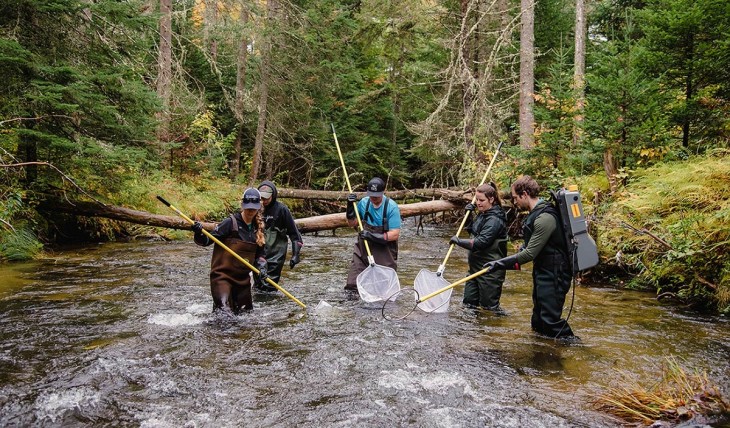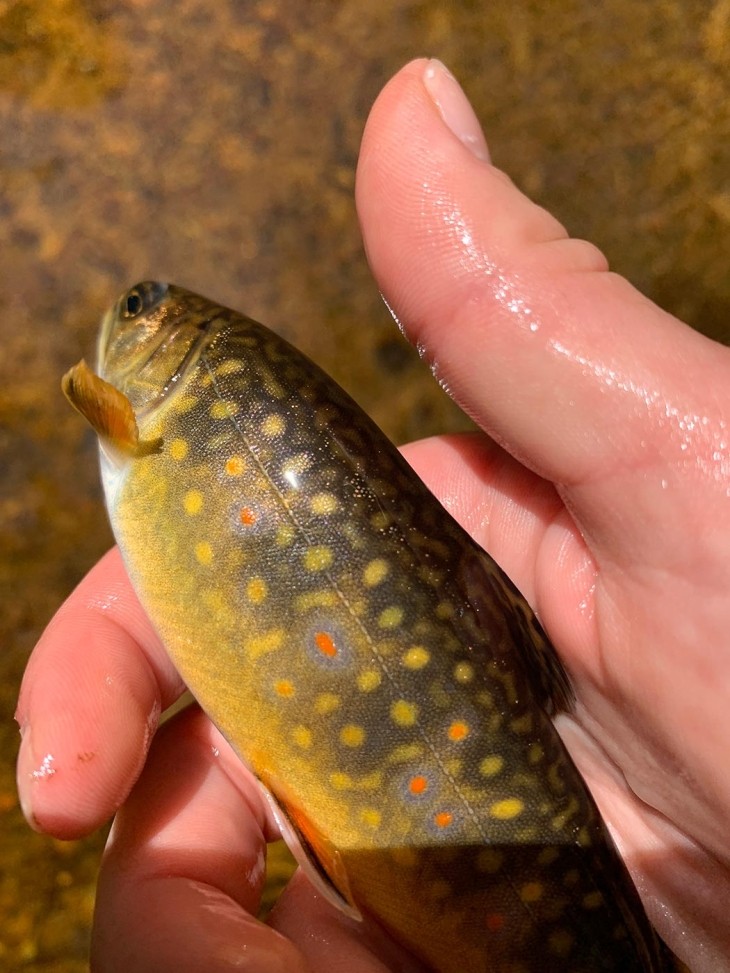
A couple of years ago, I joined colleagues from University of Rhode Island and the Rhode Island Department of Environmental Management for a day of fieldwork studying brook trout (Salvelinus fontinalis). Our “office” was the Wood River, our business attire chest-high waders. Our goal for the day was to catch and measure brook trout as part of an ongoing study on the species’ movement ecology.
Most of our group of field technicians, biologists, and students gathered in the middle of the river. Upstream, the lead biologist readied his electrofishing equipment. This consisted of a large rectangular backpack carrying a battery, connected by a wire to a 5-foot-long metal rod with a foot-wide metal hoop attached at the end. He placed the hoop – or anode – into the water, pressed a button on the backpack, and released an electric current into the river. A cable trailed from the backpack into the water. This was the cathode, which served as the end point of the current.
As its name suggests, electrofishing employs electric fields to immobilize fish, which can then be caught, analyzed, and returned alive to the water. It’s a standard method for freshwater fisheries management.
“Electrofishing allows us to track species’ presence, abundance, age, growth, survival, and more,” said Andrew Bade, supervising fisheries biologist for the Connecticut Department of Energy & Environmental Protection. “These data allow fisheries professionals to create and evaluate data-driven regulations and stocking programs; to monitor the effects of environmental changes such as warming temperatures, drawdowns, and introductions of invasive species; and to identify and protect important habitats.”
On that summer day in the Wood River, which is designated a National Wild and Scenic River, we wore rubber, waterproof waders and long, rubber gloves as protection against any spillage of the directed current. Polarized sunglasses allowed us to see through the glare on the water as we moved upstream as a group, plucking floating fish from the stream with nets and placing them in water-filled buckets.
These first fish soon began to recover and swim around the buckets, while the lead did a few more passes with the anode and we continued to net more fish. We measured each fish, identified the species, and returned it to the water.
In rare instances, for example if researchers want to more closely study growth of a given species, they may retain a few specimens. Biologists may also fit some of the fish with tracking devices before releasing them back to the stream, allowing them to study fish movements over a large landscape. The size and definition of this landscape depends on the study, and may be as small as one section of a river or as large as an entire watershed. This data can be used for a variety of purposes, such as determining climate change effects on fish, investigating fish habitat preferences or responses to habitat management, or the movements of different species relative to other fish in the community.
Introduced more than a century ago, electrofishing is a common, and relatively low-impact, technique biologists use to study fish without permanently removing them from their habitat. On larger waterbodies, electrofishing is done from a boat specially outfitted for this purpose.
Before electrofishing became common practice, some 60 years ago, biologists used lethal methods to sample fish populations, including explosives and piscicides. Both methods allowed biologists to collect large numbers of fish, but killed every fish collected. These methods can also harm a river ecosystem, both through the introduction of toxic chemicals and by removing many fish at one time from the system. This meant biologists couldn’t study one community over a long period of time.
Through the work I’ve done in Rhode Island and some sampling work in New Hampshire, my colleagues and I have been able to gather data on several species, including wild and stocked brook trout, American eels, Atlantic salmon, longear sunfish, and blacknose dace. This data informs management decisions for freshwater fish and the water where they live.


